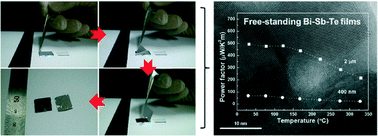Free-standing Bi–Sb–Te films derived from thermal annealing of sputter-deposited Sb2Te3/Bi2Te3 multilayer films for thermoelectric applications†
Abstract
We introduce an easily acceptable method to produce free-standing Bi–Sb–Te films from Sb2Te3/Bi2Te3 multilayer films based on solid-state reactions. When sputter-deposited Sb2Te3/Bi2Te3 multilayer films were annealed at 400 °C under a N2 gas atmosphere, they were transformed into single layers composed of Bi–Sb–Te films. At the same time, they were spontaneously stripped on a large scale from the substrates (1 cm × 1 cm) without chemical etching. The as-fabricated free-standing Bi–Sb–Te films were very flexible, with a thickness of about 400 nm. The findings confirmed that the formation of voids and the strong flow rate of ambient gas play important roles in fabricating free-standing Bi–Sb–Te films during the thermal annealing process. The temperature-dependent crystallization behaviors of each of the Sb2Te3 and Bi2Te3 films were also investigated to understand the mechanism. Moreover, the thermoelectric properties of the free-standing Bi–Sb–Te films were examined with different thicknesses of the films. We believe that this method can contribute to the development of low-dimensional nanostructures that can be useful in various applications such as energy conversion, energy storage and wearable electronics.


 Please wait while we load your content...
Please wait while we load your content...